#_author:Alexandra Ilyashov
Text
See the evolution of summer's sexiest shorts from the 1940s to the 2000s
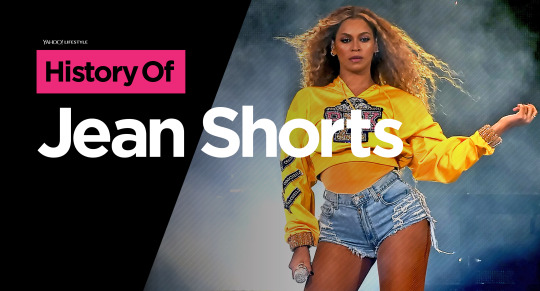
Few clothing items usher in summer quite like a perfectly worn-in, frayed, and ripped pair of denim shorts. Some call them jorts (aka jean shorts), while others might prefer “cutoffs.” They’re a 21st century festival staple and a street-style favorite, with price tags that span the gamut from a couple bucks for some vintage Levi’s dug up in a thrift store, to roughly $1K for this Valentino pair, embroidered with butterflies.
But, before there were jorts, there were jeans. It’s nearly impossible to imagine a world or closet without denim, yet the durable, universally beloved garment only dates back to late 19th century, when Levi Strauss (along with a tailor, Jacob Davis) invented “waist overalls” in 1873, named for where the style starts on the body, compared to the full-body overalls of the past.


From left to right: Students at Los Angeles City College in 1958, Karen Erickson, 19; John Zinda, 20; Annette Schiff, 19; Biggio Pennino, 21; and Al Ponce, 19, look on as Jerry Brooks, 18 (second from left), reads a campus order instructing students not to wear shorts. (Photo by USC Libraries/Corbis via Getty Images)
Shorts have been around since the early 20th century, remaining taboo through the 1930s, 1940s, and 1950s, for both men and women. There were even dress codes against, and fines for, wearing shorts, in certain cities throughout midcentury America.
Though it’s unclear when in the 20th century, exactly, the denim cutoff was born, denim itself was invented in the 1700s in Nîmes, France, and was initially touted as being completely tear-resistant. (The word “denim” actually refers to the birthplace of the sturdy fabric: it’s derived from serge de Nîmes in French, which translates as serge (a sturdy fabric) from Nîmes.


Punk rock singer and poet Patti Smith poses for a studio portrait. (Photo by Lynn Goldsmith/Corbis/VCG via Getty Images)
Long before jorts was a word — a dictionary-official one, even, but more on that later — the shorts style picked up popularity in the 1970s. The edgy twist on a beloved American staple was particularly big during the decade famous for punk and rock musicians. There’s a subtle but powerful symbolism in literally ripping apart a material that, while invented across the pond in France, had become strongly associated with American workmanship.
In the latter part of the decade, Patti Smith, a denim devotee in general, often donned pairs of roughly chopped and cuffed jean shorts, topped with oversized tweed mens’ blazers, loose T-shirts, or baggy button-downs. Smith often sported her cutoffs with black tights underneath, and wore them in a slew of situations, often photographed with her partner Robert Mapplethorpe, as well as onstage while performing.

Debbie Harry of Blondie on the beach at Coney Island (Photo by Roberta Bayley/Redferns)
Another musical icon to memorably rock the rebellious style was Debbie Harry: The Blondie frontwoman donned a very short, very ripped pair of cutoffs while cavorting on the beach in Coney Island, Brooklyn, in a series of shots from 1977 by rock photographer Roberta Bayley.


Daisy Duke, played by Catherine Bach in “The Dukes of Hazzard.” (Photo: Everett Collection)
The garment was most powerfully immortalized by actress Catherine Bach in the TV series The Dukes of Hazzard, which aired from 1979 to 1985. Bach’s character, Daisy Duke, frequently flaunted her gams in extra-short cutoffs to help her get out of perilous situations that she and her two brothers found themselves in. The hot-weather answer to denim wearing become synonymous with a stereotypical, Southern flirtatious sex appeal, thanks to the show, and bequeathed them an enduring nickname: The shorts are (still!) often called “Daisy Dukes.”
However, despite their breezy, bare-legged appearance, the cutoffs featured on The Dukes of Hazzard weren’t exactly styled in the most beach-friendly manner. The show’s network, CBS, deemed the minuscule shorts inappropriate for TV, and Bach had to wear flesh-hued tights under her cutoffs in every scene.


Behind the scenes on “Stunt Women”: Cindy Crawford in 1992 (Photo: Shutterstock)
Cutoffs got the Vogue treatment in the early 1990s. Supermodel Cindy Crawford wore a pair as part of a photoshoot on a Malibu beach in 1992, Herb Ritts shot Cindy Crawford for the November issue of Vogue, cavorting on the beach in Malibu with her husband at the time, Richard Gere, her supermodel physique displayed nicely in a pair of frayed Levi shorts. Before cutoffs made a Vogue cameo, their full-length predecessors were notably featured on the fashion bible’s cover four years before, when the magazine’s then newly minted editor-in-chief, Anna Wintour, featured a pair of blues on her very first cover, in 1988.
A big part of the charm of cutoffs is how democratizing and DIY-friendly they are; crafted for a couple bucks, or free, even, using any old pair of jeans and a sharp pair of scissors. The advent and popularity of the premium denim market in the late ‘90s and early aughts ushered in previously unheard-of triple-digit prices for the wardrobe workhouse, from brands like Frankie B, Seven for All Mankind, Paper Denim & Cloth, and True Religion. Shorts versions of pricy premium denim also took off, whether intentionally sold with abbreviated hemlines or in DIY form.


A model on the runway at the Spring/Summer 2000 Chloé ready-to-wear collection designed by Stella McCartney, wearing white tube top with smocking at top edge, fringed hot pants, high-heel sandals with white and gold ankle bands, and carrying a straw bag with cat-face design. (Photo: Getty Images)
But the humble cutoff has also gotten more upscale runway treatments: In 1999, for one of Stella McCartney’s final collections as creative director of Chloé, she showed ultrashort white shorts with a low rise (as was the preferred, hipbone-exposing silhouette of the era) and extra-distressed hems.
Then, the shorts reconnected with their musician-vetted roots in a new way, thanks to their growing ubiquity with festival fashion. Specifically, with one increasingly popular festival: Coachella. The annual three-day blowout in the desert of Indio, Calif., which began in 1999, is where many a trend has hit critical mass in the 21st century, particularly in the past five to 10 years, be it jorts, flower crowns, or chokers.


Jessica Simpson in the film version of “The Dukes of Hazzard.” (Photo: Everett Collection)
In 2005, Jessica Simpson introduced Daisy Duke (both the character and her signature shorts) to a younger generation with the film version of The Dukes of Hazzard. Unlike the O.G. Daisy Duke, Simpson didn’t wear tights under her cutoffs. Plus, the entire ensemble (both the shorts’ length and fit, and the snugness and cleavage-baring factor of her tops) were sexed up in the modernized, silver-screen take on the campy TV series.


Kendall Jenner in 2016, wearing a fringe jacket, jean shorts, and velvet boots. (Photo: Getty Images)
In 2015, the term “jorts” became a legitimate, official noun: the term, a portmanteau of “jeans” and “shorts,” was added to the Oxford dictionary that year, along with other modern vernacular, like selfie, twerk, and guac.
In the past decade, denim cutoffs have yet again cropped up on runways, in their fanciest, priciest form fathomable. During designer Hedi Slimane’s stint as creative director at Saint Laurent from 2012 to 2016, one of the (many) sweeping tweaks he made to the venerable French fashion house was peppering his collections with supershort hemlines and punky vibes, sometimes translating to cutoff shorts (and even cutoff denim overalls, like this spring 2016 Saint Laurent look).

Alexander Wang Spring-Summer Collection 2016 at New York Fashion Week (Photo: Getty Images)
Alexander Wang trotted out some artfully beat-up, ultrashort pairs in his fall 2016 collection, too. 2016 also marked the year supermodels Kendall Jenner and Gigi Hadid added jorts to their model-off-duty street style.
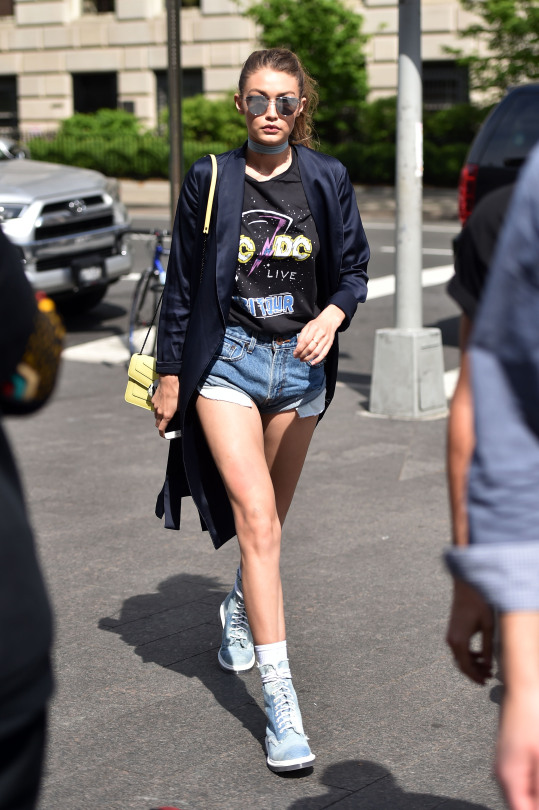
Gigi Hadid in 2016 wearing jean shorts, a T-shirt, and navy coat. (Photo: Getty Images)


Beyoncé wears the Saint Laurent sparkle boots alongside Jay-Z. (Photo: Instagram)
The most epic jorts moment in recent memory came courtesy of the one and only Beyoncé, at what’s become the most important modern natural habitat for the garment: Coachella. While headlining the festival in April 2018, Queen Bey slayed in her first of five outfit changes throughout her set: a heavily shredded, customized pair of Levi’s High-Rise shorts, paired with a bejeweled yellow satin hoodie, flesh-toned fishnets, and iridescent sequined boots. The superstar had another memorable cutoffs getup a couple months earlier, in December 2017, thanks to a pair of black cutoffs paired with glittery Saint Laurent knee-high boots.


Beyoncé at this year’s Coachella Valley Music and Arts Festival in April in Indio, Calif. (Photo: Getty Images)
These days, denim cutoffs are less associated with their late 20th century connotations of Daisy Duke and punky DGAF rock legend style, and more with celebrity street style (and, of course, festival garb).
A plethora of stars regularly don cutoffs, both off-duty and, occasionally, on the red carpet. To wit: famous fans of jorts include Kate Moss, Taylor Swift, Kim Kardashian, Victoria Beckham, Gigi Hadid, Rihanna (in another epic Coachella getup, pairing jorts with a Gucci bejeweled bodysuit and matching balaclava), and longtime cutoffs connoisseur, Chloë Sevigny.
So, just like the enduring, universal appeal of jeans — despite changing silhouettes, rises, and inseam lengths that cycle in and out of trendiness over the years — denim cutoffs are the indispensable warm-weather counterpart.
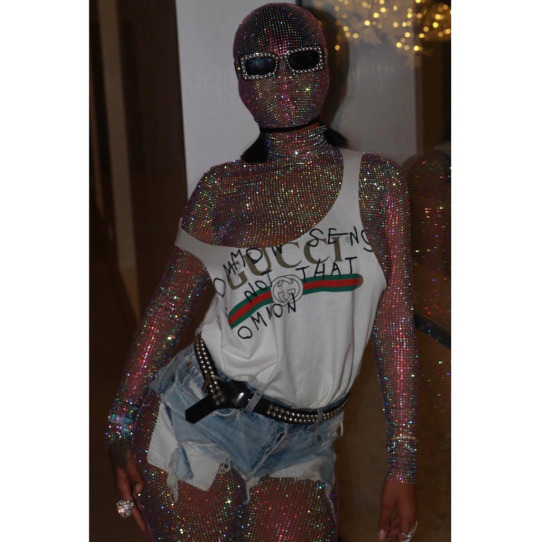
Rihanna wears a Gucci sparkle bodysuit and balaclava with her jorts at Coachella. (Photo: Instagram)
The appeal varies widely: For some, there’s a sort of Southern sexpot vibe, thanks to the surprisingly sartorially memorable television character, Daisy Duke, while others might associate with it a punk-rock insouciance, à la Patti Smith. Or, perhaps, a carefully curated but “carefree” quintessential Coachella look.
Expect this wardrobe staple to stick around for many more decades, sure to be championed by a new generation of style icons, across music genres and various creative fields, personal style preferences, and price points. In other words, love them or loathe them, in all likelihood, jorts are here to stay.
Read More from Yahoo Lifestyle:
• See the evolution of the prom dress from the 1940s to the 2000s
• Olympian Adam Rippon on coming out before a major skating competition: ‘I felt power going out there’
• Innovative, resilient, woke: Ready or not, Generation Z has arrived
Follow us on Instagram, Facebook, and Twitter for nonstop inspiration delivered fresh to your feed, every day.
yahoo
#_revsp:wp.yahoo.style.us#jean shorts#The history of#jorts#_uuid:bce9fa5d-d942-3b5f-a503-e8d43b99779a#style#history#beyonce#summer#_author:Alexandra Ilyashov#_lmsid:a0Vd000000AE7lXEAT#fashion
4 notes
·
View notes
Text
The history of the prom dress

How the prom dress has evolved over the years. (Photo: Everett Collection, Art: Quinn Lemmers)
The prom has endured as a meaningful teenhood tradition for decades: It’s a hotly anticipated toast to high school, playing a pivotal part of basically any teen flick worth its salt (not to mention how pivotal it can be IRL too).
But the true roots of prom — short for “promenade” — are as a rite of passage, debuting at Northeast colleges such as Harvard University and Amherst College in the mid- to late 19th century, as relatively simple farewell dances for graduating classes. The practice skewed younger in the decade that followed, emerging as a teen tradition at high schools by the 1940s. Proms are held at some Canadian high schools, and they have also caught on to a lesser extent — and with a younger demographic — in the past decade or so in the U.K., although it hasn’t expanded much farther globally.
Proms are just one type of coming-of-age ceremony, along with quinceañeras, bar/bat mitzvahs, Catholic communions and confirmations, debutante balls, and weddings. All these rites of passage, and the carefully chosen clothes that are worn on these special occasions, have stuck around. But the prom dress differs from most rite-of-passage fashion traditions: It’s nonsecular, and not tied to any particular ethnicity, and, thus, it’s more universal.
It’s also the rare coming-of-age garment that can, and often does, telegraph a teen girl’s burgeoning sexuality, as sociologist Amy Best explores in her 2000 book, Prom Night: Youth, Schools, and Popular Culture. “The prom dress is critically important to this invention of a sexual self,” Best writes, detailing how she overheard some of the girls she interviewed describing their fathers’ “utter discomfort” upon seeing their risqué getups for the big night, which provide proof “that the girls had succeeded in transforming themselves.”


1942: High school seniors at their prom in Greenbelt, Md. (Photo: Getty Images)
Granted, the prom dress wasn’t very sexy at its midcentury inception. Prim and ultrafeminine was the M.O. instead. In the 1940s, prom dress silhouettes were often cut slim and close to the body. This wasn’t done for the sake of a sexier, more body-con dress: It was due to WWII fabric rations. These frocks had higher necklines and covered shoulders (often with some pouffy volume at the shoulders), with floor-grazing hemlines, often fabricated from heavy materials like velvet and taffeta.


1954: Prom in Cloyne, Canada (Photo: Wikicommons)
Ultrafeminine, waist-whittling tea-length dresses dominated the fashion vernacular in a big way in the 1950s, and it was the preferred shape for promgoers during that midcentury period too. The style includes fitted waists, full skirts, and calf-grazing hems, falling 3 to 4 inches below the knees. (Interestingly, the term “tea length” actually dates back to the dresses women wore when having teas circa the 1920s.) Some styles even were bedecked with frilly ruffles. Necklines were less demure than in previous decades, for the most part, and strapless styles were also common.

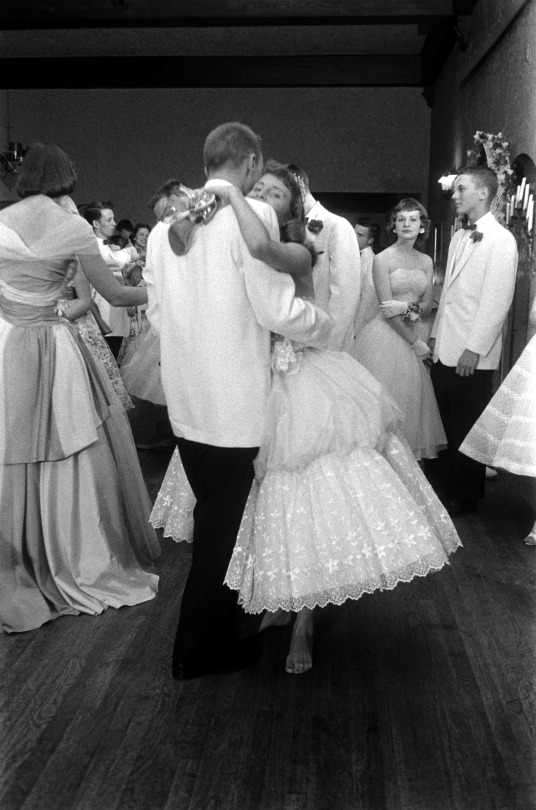
1960s: Students dancing at the Mariemont High School prom in Cincinnati. (Photo: Getty Images)
The early ‘60s brought about a return to closer-cut skirting that had been de rigueur two decades earlier, but purely for aesthetic reasons — not as a cost-cutting measure. Slimmer skirts were paired with higher waistlines, making for more of a baby-doll silhouette. Pastel palettes with Easter egg-worthy hues were popular, and dresses moved toward spaghetti-strap and boatneck shapes up top. Later in the decade, empire waist shapes rose to prominence, paired with a range of necklines, like sleeveless boatneck styles and square-neck short-sleeved iterations. And throughout the ‘60s, ultra-voluminous coifs were the norm.
However, proms fell out of favor to an extent as the decade wound down, thanks to shifting cultural attitudes based on political events and attitudes of the time: “The prom’s popularity waned in the late ‘60s and early ‘70s,” Best writes in Prom Night. “With countercultural movements, antiwar protests, and an antiestablishment stance, many ‘irreverent’ youth brought proms to a halt.”


1975: Susan Ford and her date, William Pifer, dance during the 1975 Holton Arms School Senior Prom, held in the East Room of the White House. (Photo: Getty Images)
In the 1970s, many prom dresses, reflecting the wider dress trends of the era, became roomier in cut, often without any definition at the waist whatsoever. Unlike the strapless, snug bodices or sleeveless styles that were dominant in previous decades of prom dressing, these frocks tended to have off-the-shoulder, possibly lace-trimmed necklines or long sleeves that were often sheer or billowy.
On the silver screen, Carrie depicted a considerably less dowdy take on the trend: a clean-lined strappy gown with a fluid skirt. Another iconic ‘70s prom dress was worn at the first, and only, prom to be held at the White House: Susan Ford, daughter of President Ford, donned a flowy, salmon-hued jersey gown designed by Albert Capraro, a former assistant to Oscar de la Renta. The frock was trimmed with a few buttons, plus a massive orchid corsage (as her classmates had).
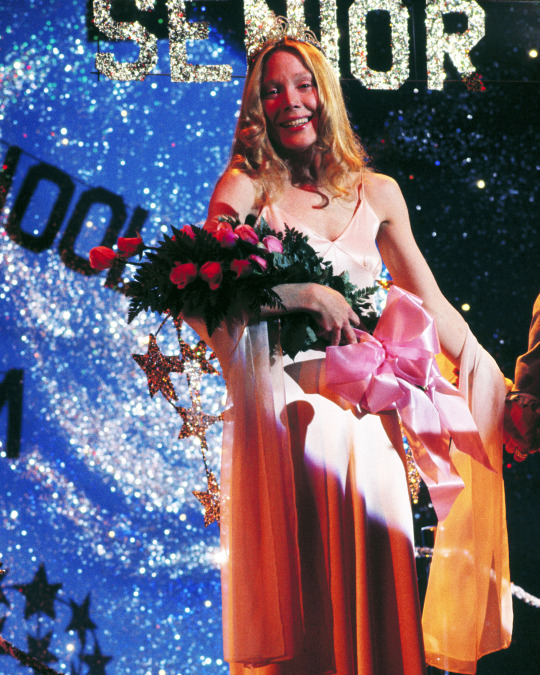
1976: Carrie White, played by Sissy Spacek, is unexpectedly elected prom queen in Brian De Palma’s horror film Carrie. (Photo: Getty Images)
A major prom milestone of the ‘70s was the founding of Jessica McClintock: The brand, created by a former schoolteacher with no formal design training, went on to become synonymous with prom dressing in the ‘80s and ‘90s, and also did big business with bridesmaid gowns and other formalwear during those decades. While the designer herself retired in 2014, and her namesake stores were shuttered around the same time, the label still has licensing deals for some products, such as fragrances.


1986: Jon Cryer and Molly Ringwald in the film Pretty in Pink. (Photo: Everett Collection)
The maximalism of all things ‘80s certainly didn’t spare the prom dress category. The extravagant excess of the era translated to ultra-pouffy details like oversize bows or ruffles and flashy metallic materials. Tresses were teased and/or crimped, and the makeup of the era tended to be equally as over the top: heavily pigmented lids, copious amounts of self-tanner, and bold lips.
But the most memorable ‘80s prom dresses were certainly in the multiplex, as the teen-movie genre really solidified and took off in the decade, thanks in no small part to John Hughes’s iconic flicks. Take, for example, the pale pink dress — a thrift-store hand-me-down that gets some considerable revamping — worn by Andie (Molly Ringwald) in the seminal 1986 teen classic Pretty in Pink.


1990s: Jennie Garth and Shannen Doherty in Beverly Hills 90210. (Photo: Fox)
In the early part of the ‘90s, prom frocks looked quite similar to those of the ‘80s in terms of having lots of pouf and ample metallic hues. Sweetheart necklines became quite popular for promgoers (and for fancy occasions in general), and while form-fitting bodices endured, the silhouette shifted slightly, with waistlines hitting closer to the hips.
Shorter hemlines with dramatic necklines were common too, among prom-worthy minidresses of the early ‘90s. To wit: the identical black tube dresses with massive, white bow-adorned off-the-shoulder necklines worn by both Brenda Walsh (Shannen Doherty) and Kelly Taylor (Jennie Garth) on an episode of Beverly Hills 90210 in 1993. The style was so iconic, it inspired a runway look nearly a decade later, when designer Isaac Mizrahi trotted out a similar frock in his resort 2011 collection.
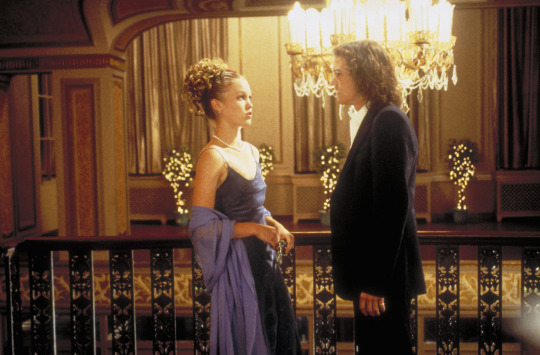
1999: Julia Stiles and Heath Ledger in 10 Things I Hate About You. (Photo: Everett Collection)
Later in the decade, slinky, spaghetti-strap slip dress or sheath styles reigned supreme. Recalling the iconic and ill-fated style that Sissy Spacek wore (and got drenched in pig blood) in Carrie, two decades before. These styles represented a trickle-down from what was seen on the runway during the era, most memorably in Calvin Klein collections circa the ‘90s. Two epic teen flicks that debuted on the silver screen in 1999 showcased the style: Kat Stratford (Julia Stiles) in a deep purple gown with a lavender shawl in 10 Things I Hate About You, and Laney Boggs (Rachael Leigh Cook) in her post-makeover prom reveal, replete with a sparkly, skinny-strapped LBD.
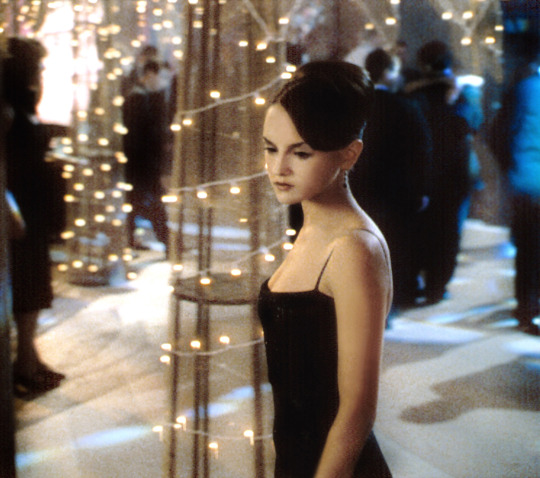
1999: Rachael Leigh Cook in She’s All That. (Photo: Everett Collection)
Other popular silhouettes of the ‘90s included skinny-strapped halter styles, which flaunted ample shoulder and back. As for length, a mix of floor-grazing gowns and minidresses ruled late ‘90s prom dance floors.


Rachel Bilson and Mischa Barton in The O.C. (Photo: Fox)
The new millennium brought about a mishmash of prom trends (spurred by the era’s prevailing fashion trends). Think: bubble-hemmed looks, like a wildly unrealistic, straight-off-the-runway Chanel frock worn by Marissa Cooper (Mischa Barton) to the prom on The O.C. in 2006. Strapless gowns with lots of shirred detailing were, and continue to be, popular, often sporting some level of sparkly embellishments and resembling colorful, slightly less voluminous iterations of wedding dresses. Sweetheart necklines, one-shouldered styles, and halter-style necklines were also popular.
Prom dress styles have certainly evolved — and gotten more scintillating — in the past two decades, becoming a more controversial topic in the process. Some schools have enforced restrictive and often sexist dress codes, which tend to predominantly control what girls can and can’t wear to the big event. By the 2010s, risqué prom dresses entered the picture, such as ones sporting dramatic cutouts, which tend to resemble the most revealing of Miss Universe getups or professional dance competition looks.
Social media and the evolution of celebrity red carpet style are largely responsible for these saucier prom looks, which include midriff-flaunting two-piece sets, ultrahigh slits, and sheer overlays on supershort minidresses (the latter lends a sense of modesty to a short, potentially controversial silhouette).
As for prom dresses of the 2020s and beyond, perhaps they’ll stay consistent with the styles dominating dance floors currently. Or the ’20s may usher in an entirely new era of prom frocks, continuing the decades-long tradition of getting gussied up for one last, festive hurrah of the all-important teen years.
Read more from Yahoo Lifestyle:
• This teen wore a Michelle Obama suit jacket to prom to honor the ‘strong black women’ who raised him
• This gay couple is fighting for their right to be their high school’s prom king and king
• This teen is going viral for DIY’ing a $4 thrift-store dress into her ‘dream prom dress’
Follow us on Instagram, Facebook, and Twitter for nonstop inspiration delivered fresh to your feed, every day.
yahoo
#Jessica McClintock#coming of age#Prom#Fashion#prom dresses#_draft:true#teens#_author:Alexandra Ilyashov#_lmsid:a0Vd000000AE7lXEAT#dances#_revsp:wp.yahoo.style.us#Prom Dress#The O.C.#Prom 2018#She's All That#Pretty in Pink#_uuid:657bc3e1-2f14-36f6-b085-c7aa0546b7b5#10 Things I Hate About You#Albert Capraro#Style#dresses#rite of passage#The History Of#Carrie
6 notes
·
View notes